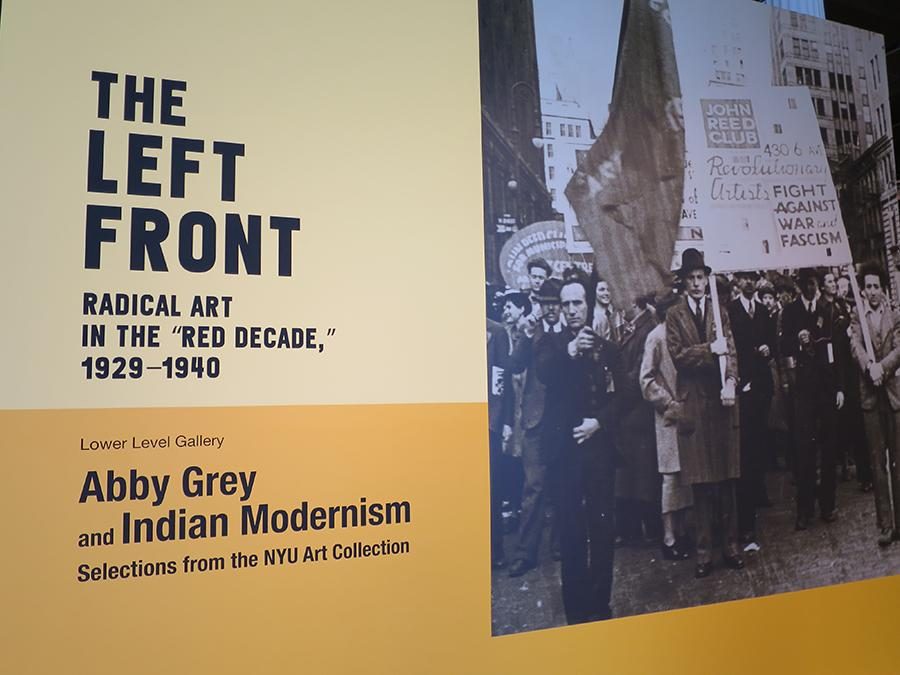‘Left Front’ exhibit is radical
“The Left Front: Radical Art in the ‘Red Decade’ 1929-1940” will be on display at Grey Art Gallery until April 4.
February 24, 2015
Just under the Silver Center for Arts and Science, Grey Art Gallery is displaying a gallery of artwork from the red decade. “The Left Front: Radical Art in the ‘Red Decade’ 1929-1940” captures the spirit of American artists on the left during the Great Depression and before World War II.
John Murphy, a doctoral candidate at Northwestern University and co-curator of “The Left Front,” said the exhibit maintains a balance between negativity
and optimism.
“The hope was that by exposing some of the problems in the system, confronting it very directly, it would shake people out of their lethargy,” Murphy said. “I think this is an optimistic view of what art can do.”
The exhibit is divided into two time periods. The first part of the exhibit focuses on the Revolutionary Front, which dates from 1929-1935. The second part focuses on the Popular Front, which lasted from 1935-1940. Several subsections divide the chronological exhibits, including “Class Struggle” and “Workers of the World Unite!”
The first two sections of the exhibit illustrate the previous harsh realities facing the American labor movement during this time. Upon entering the gallery, visitors turn the corner to see Morris Topchevsky’s “Unemployed.” In the painting, a man in gray sits on a sidewalk curb with his head buried dejectedly in his arms. As well, downtrodden prints of Depression-era workers are showcased alongside a haunting painting of police firing into a group of
labor strikers.
In the second half of the exhibit, the focus shifts to the horrors of European fascism. For example, one work responds to the bombing of Guernica, as the artist uses quick strokes, loose lines and dark colors to criticize attacks on defenseless civilians. The pieces are gritty and dark, from Carl Hoeckner’s grisly depictions of war to Rockwell Kent’s dreamlike renderings of apocalyptic celestial events.
The gloomy prints contrast sharply with a bright red Spanish Civil War propaganda poster that is placed between them. A rough, muscular man looks determinedly over his shoulder and a patriotic slogan runs along the bottom of the poster.
A display of the Birobidzhan portfolio cuts through the center of the gallery. These woodcuts, created by Jewish artists, were originally meant for an art museum in the Soviet-established safe zone for Jews. The portfolio includes sympathetic renderings of a better future for Jews in Europe. Next to this series of woodcuts hangs a moving statement on the gallery wall: “The portfolio never arrived at its intended destination, and the citizens of the Biro-Bidjan region fell victim to famine, poverty, and disease.”
The highly emotional content of the “The Left Front” makes this era of art history accessible to the general public. The exhibit successfully conveys the anxiety and disillusionment following World War I, the Great Depression and the rise of European fascism. Although divided into distinct sections, the exhibit unifies all four parts by continually drawing parallels between the oppression of American labor workers and the cruelty of the fascists. In both cases, armed and organized forces threatened innocent,
defenseless civilians.
The exhibit accomplishes a multilayered exploration of this decade’s left-leaning artists. The art conveys their disillusionment with capitalism and society, but also their hope for a revived civilization under leftist principles. Although many pieces are dark and gritty, there remains a sense of faith in art’s ability to change the world for the better.
“The Left Front” is on display in Grey Art Gallery until April 4.
A version of this article appeared in the Tuesday, Feb. 24 print edition. Email Jessica Tien at [email protected]
























































































































































